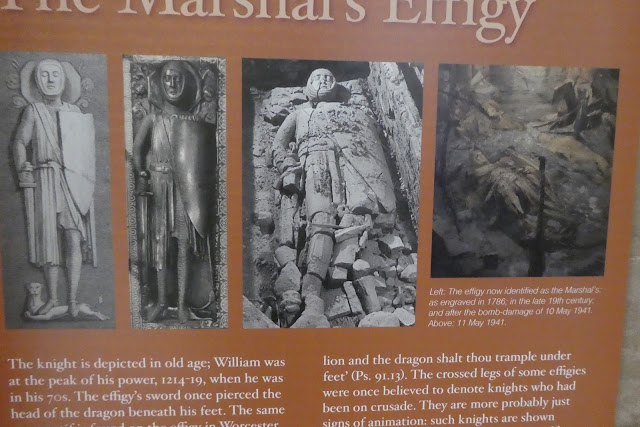 |
| WILLIAM MARSHAL first Earl of Pembroke (died 1219) |
Believe
it or not, the Knights Templar were not a fantasy created for a Dan Brown
novel. They were living people in the middle ages. Thanks to genealogists like Gary Boyd Roberts and
William Addams Reitwiesner, I have traced my family tree back to William
Marshal (about 1146 – 1219), my 23rd great grandfather. He was buried as a Knight Templar in the
Temple Church of London in 1219. Because
of this, I have always wanted to return to London and visit the Temple Church,
and see his effigy.
I
descend from his daughter Eve Marshal (about 1206 – 1246) who married William
de Braiose. This lineage goes down through
Judith Lewis (1626 – 1688), my 9th great grandmother, who married James Gibbons (about 1614 – 1692), an early settler at York County, Maine. This kind of ancestor is called a “gateway
ancestor” because they connect you to a noble or royal lineage. This is the kind of ancestor you can find in
books by Gary Boyd Roberts or on the Reitwiesner website. There are only a few of these immigrants who
qualify as “gateway ancestors”, but they fill up books with names like Medieval
English Ancestors of Certain Americans or The Royal Descents of 600
Immigrants to the American Colonies or the United States. This line
from William Marshal to James Gibbons was confirmed in the book Ancestral
Roots of Certain American Colonists who came to America before 1700, by
Frederick Weis Lewis and Walter Sheppard, 1995.
It’s not
often you can go back 23 generations in your family tree. But because noble and
royal marriages were (and in some cases still are) so important for legal
contracts, political alliances, and family connections they were always
carefully documented. The lower classes
often had no record at all of marriages, births or deaths until about the late 1500s when one of the Pope passed an edict on record keeping. The Protestant churches followed up with records, too, after the Reformation.
 |
| detail of the face of William Marshal's cast effigy |
 |
| The Temple Church, London |
The Temple Church dates from 1162, and is a round church to represent the Church of the Holy Sepulchre in Jerusalem. A rectangular chancel was added in 1240. It was built by the Knights Templar as their London headquarters. During the crisis that lead to the Magna Carta in 1235, King John took shelter here in the Temple Church. William Marshal, the First, and his son, William Marshal II are both buried here, and both were at Runnymede for the signing of the Magna Carta.
In the 14th century the Templars were suppressed, and James I gave all the Templar land including the church to the societies of the Inner and Middle Temple, which are two of London's famous Inns of Court. It was interesting to learn about the Templar's connection with the Magna Carta, and the current legal system in London which is centered in this area of the city.
The Temple church was restored after World War II after extensive bombing damage destroyed the roof, and molten lead heavily marred and broke the effigies. It is still a working church with a community of parishioners. This church was featured in Dan Brown's book The Da Vinci Code, in a scene where Langdon is searching for clues left by the Templar Knights.
I was not aware of the damage done to William Marshall's effigy until I visited the Temple Church last month and saw the displays, including this information board (above). The bomb damage to the effigy is heart breaking. Fortunately it was skillfully repaired, and I cannot explain how wonderful it was to see the cast of the original effigy made in 1850. I can only compare it to finding an LDS microfilm of a church register for a congregation that had burned and lost or damaged all its documents!
 |
| More information on William Marshal, 1st Earl of Pembroke "The Greatest Knight That Ever Lived!" |
------------------------------
Heather Wilkinson Rojo, "Tombstone Tuesday ~ A Knight Templar and His Effigy", Nutfield Genealogy, posted November 7, 2017, (https://nutfieldgenealogy.blogspot.com/2017/11/tombstone-tuesday-knight-templar-and.html: accessed [access date]).




Beautiful story! The photos are awesome too. What an exciting discovery.
ReplyDeleteThanks! I waited a long time (years) to get to London to see this church!
DeleteOh thank you for this, he is in my line also and since I will most likely never get to England, this was the next best thing! I have a wonderful book about him that is packed away at the moment or I would tell you the title & author. His daughter wrote about his life also.
ReplyDeleteWhat an incredible find! As you point out, it is quite rare to be able to document that far back. And I always say if you were going to live in Medieval times, it would be much better to be nobility!
ReplyDeleteThanks, Vera Marie! Yes, it is difficult to trace a lineage that far back unless you have one of those "gateway" ancestors with a noble background. The common people were not recorded.
DeleteOh my, how interesting to find this! I happen to now be reading Elizabeth Chadwick's series about William Marshall. I just finished "The greatest knight : the unsung story of the queen's champion " and am now reading "To defy a king." William is heavily featured in the Alinore of Aquitaine series as well. I have lines of descent from three of his daughters.
ReplyDelete